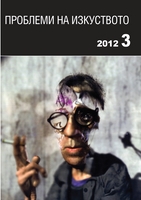Българското игрално кино от началото на ХХІ век
Bulgarian feature cinema in the beginning of the 21 century
Author(s): Ingeborg Bratoeva-DaraktchievaSubject(s): Theatre, Dance, Performing Arts
Published by: Институт за изследване на изкуствата, Българска академия на науките
Summary/Abstract: This study is based on the idea that the post-war Bulgarian cinema develops in the context of three identity-crises: the first of them happens in the late 40’s as a result of the totalitarian social model. The second arises after 1968, caused by the suppressing of the Prague spring, and the failure of the illusion about the socialism with a „human face”. The third identity crisis influences the filmmaking in Bulgaria by the end of the 20 century, as a consequence of the big social changes and the intensive European integration. The third identity-crisis became the main theme of the new Bulgarian cinema, revealing a contemporary aspect of the correlation between the art of moving image and the social reality. Focusing on the identity- crisis, the new Bulgarian cinema has developed two narrative models. I describe the first - concerned with the revisiting of the past, especially the communist period – as a Search of the lost identity. The second model, labeled in my text as a Search of new reference points, is based on the reflection on the present day. In their successful attempts (Letter to America, The Devil’s Tale, Eastern plays, Tilt, HDSM, Shelter, Ave etc.) the two models offer fresh approaches to the social drama genre. The key point of reference of my analysis is the efforts of Bulgarian filmmakers during the last two decades to overcome the cultural isolation, imposed on Bulgarian culture by the communist regime. The main ambitions of the middle and the youngest generation of Bulgarian filmmakers are to embrace a perspective of intensive European collaboration and to contribute to the building of a new European identity. The new generation of Bulgarian filmmakers, developing their skills and talents with European funding, and in collaboration with their international colleagues, is trying to exploit different cinema styles, adequate to the lifestyle and the world view of their young audiences.
Journal: Проблеми на изкуството
- Issue Year: 2012
- Issue No: 3
- Page Range: 3-8
- Page Count: 6
- Language: Bulgarian
- Content File-PDF

